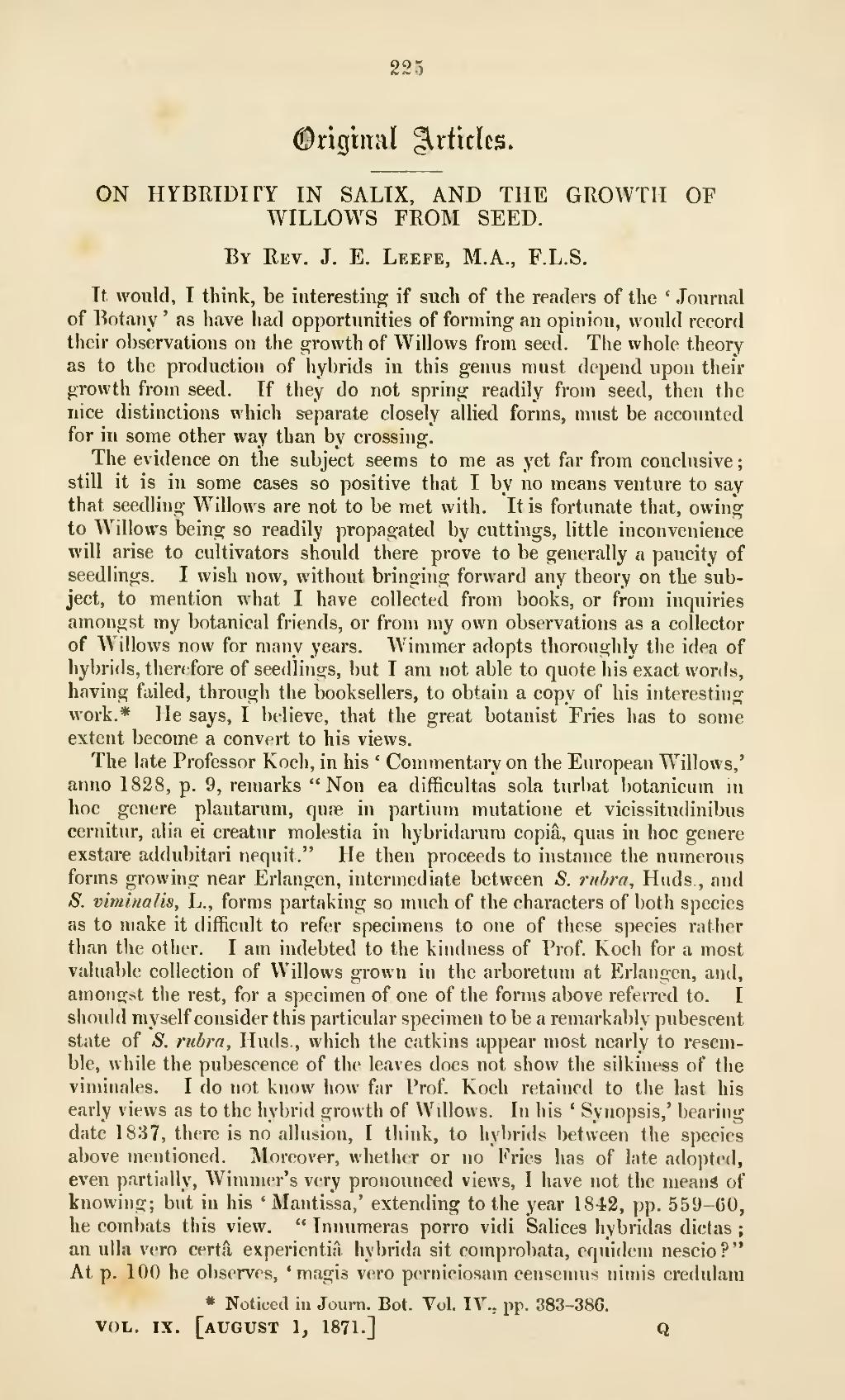225
��#ngrital girtklcs.
��ON HYBRIDirY IN SALTX, AND THE GROWTH OP WILLOWS FROM SEED.
By Rev. J. E. Lkefe, M.A., F.L.S.
It would, I think, be iuterestino^ if such of the readers of the ' Journal of Botany ' as have had opportunities of forming an opinion, would record their observations on the growth of Willows from seed. The whole theory as to the production of hybrids in this genus must depend upon their growth from seed. If they do not spring readily from seed, then the nice distinctions which separate closely allied forms, must be accounted for in some other way than by crossing.
The evidence on the subject seems to me as yet far from conclusive; still it is in some cases so positive that I by no means venture to say that seedling Willows are not to be met with. It is fortunate that, owing to W^illows being so readily propagated by cuttings, little inconvenience will arise to cultivators should there prove to be generally a paucity of seedlings. I wish now, without bringing forward any theory on the sub- ject, to mention what I have collected from books, or from inquiries amongst my botanical friends, or from my own observations as a collector of Willows now for many years. Wiramer adopts thoroughly the idea of hybrids, therefore of seedlings, but I am not able to quote his exact words, having failed, through the booksellers, to obtain a copy of his interesting work.* He says, I believe, that the great botanist Pries has to some extent become a convert to his views.
The late Professor Koch, in his ' Commentary on the European Willows,' anno 1828, p. 9, remarks " Non ea difficultas sola turbat botaniciim in hoc genere plantarum, qnpe in partium mutatione et vicissitudinibus cernitur, alia ei creatur molestia in hybridarum copia, quas in hoc genere exstare addubitari nequit." He then proceeds to instance the numerous forms growing near Erlangen, intermediate between S. mhra, Huds., and S. viminaUs, L., forms partaking so much of the characters of both species as to make it difficult to refer specimens to one of these species rather than the otlier. I am indebted to the kindness of Prof. Koch for a most valuable collection of Willows grown in the arboretum at Erlangen, and, amono-st the rest, for a specimen of one of the forms above referred to. I should myself consider this particular specimen to be a remarkably pubescent state of S. rubra, Huds., which the catkins appear most nearly to resem- ble, while the pubescence of the leaves docs not show the silkiness of the viminales. I do not know how far Prof. Koch retained to the last his early views as to the hybrid growth of Willows. In his ' Synopsis,' bearing- date 1837, there is no allusion, I think, to hybrids between the species above mentioned. Moreover, whetiier or no Fries has of late a(lo])ted, even partially, Wimnier's very pronounced views, I have not the mean* of knowing; but in his ' Mantissa,' extending to the year 1842, pp. 559-60, he combats this view. " Innumeras porro vidi Salices hybridas dictas; an ulla vero certa experientia hybrida sit comprobata, equidem nescio?" At p. 100 he observes, ' magis vero perniciosam censcmus nimis credulam
- Noticed in Journ. Bot. Vol. lY., pp. 383-38G.
VOL. IX. [august 1, 1871.] Q
�� �
